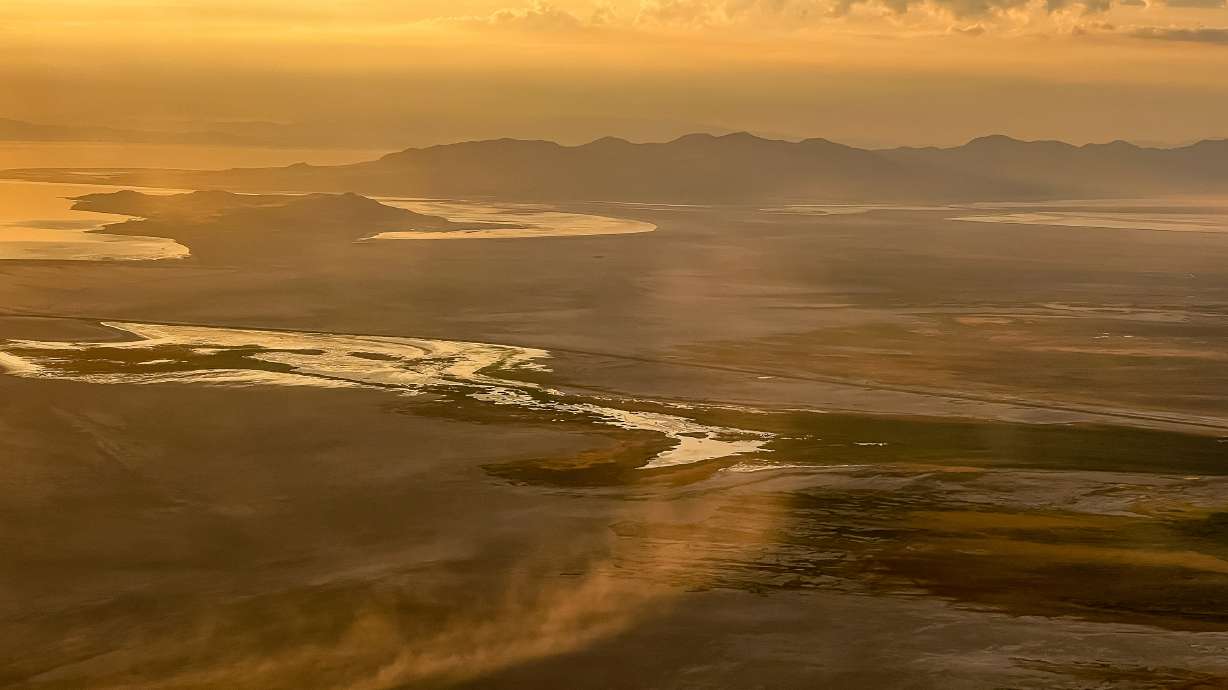Estimated read time: 4-5 minutes
This archived news story is available only for your personal, non-commercial use. Information in the story may be outdated or superseded by additional information. Reading or replaying the story in its archived form does not constitute a republication of the story.
Editor's note: This article is published through the Great Salt Lake Collaborative, a solutions journalism initiative that partners news, education and media organizations to help inform people about the plight of the Great Salt Lake.
SALT LAKE CITY — Utah Gov. Spencer Cox says he isn't surprised by a new report showing that mitigating dust from the Great Salt Lake would likely cost at least $1.5 billion in capital costs, but it highlights why the state is "so passionate about getting more water" into the drying lake.
The Utah Office of the Legislative Audit General released a report on the state's "critical vulnerabilities" this week, which notes Great Salt Lake dust mitigation is "estimated to be at a minimum $1.5 billion in capital costs with ongoing annual maintenance of $15 million," increasing in cost as more of the lakebed is exposed.
That cost, the report adds, is on top of the "ecological impacts" associated with the lake drying, which could "damage Utah's public health and environment and threaten billions of dollars in economic activity."
The report highlights this risk in a section about the state's water optimization program, which was created in 2018 to address ways to reduce agricultural water consumption. The program is considered one of the ways Utah can "increase the water supply throughout the state and minimize environmental impacts, such as dust mitigation," the report states.
When asked about it during his monthly news conference with Utah reporters on Thursday, Cox said the findings didn't provide "anything we didn't already know" about the cost of dust mitigation, but it does underscore the importance of programs that help bring more water to the lake.
"It's less expensive to do that, than to mitigate the dust," he said, before pointing to issues with Owens Lake in California.
Owens Lake began to dry up when Los Angeles officials diverted the saline lake's water sources into the Los Angeles Aqueduct over a century ago. California has spent $2 billion on mitigation efforts, to no avail.
"We always knew that was a potential issue and it would not be millions of dollars, but potentially billions of dollars," Cox said, of the drying Great Salt Lake. "That number really wasn't a surprise to us. We've been operating with that in the back of our minds all of the time. ... It's so critical to preserve these wetlands for economic reasons, for ecological reasons, but also for health reasons, and it saves taxpayer dollars to get water there so there isn't dust, versus the other way around."

The Great Salt Lake's water levels fell to an all-time low last year, but its southern arm reached a little more than 4,194 feet elevation this summer as the result of a robust water year. It has since dropped about 2 feet as a result of water consumption and evaporation in recent months. The lake's northern arm remains close to its all-time low as efforts to preserve the southern arm hampered its growth.
Even with the strong water year, the lake's levels remain about 6 feet below what is considered healthy for the lake.
The governor said Utahns have been able to use less water in recent years, to mitigate drought concerns, which helps put water in the lake. But environmental groups filed a lawsuit against the Utah Department of Natural Resources and a pair of its divisions earlier this month, arguing the state isn't doing enough to get water to the lake.
"The baby steps Utah has taken at the Great Salt Lake are woefully inadequate to sustain the American West's largest wetland ecosystem," Zach Frankel, executive director of the Utah Rivers Council, said after the lawsuit was filed in 3rd District Court.
Cox declined to respond to the allegations outlined in the lawsuit when he was also asked about it on Thursday, saying he was advised to not talk much about ongoing "legal issues."
The governor did say, however, that he would "ask the partners out there to be constructive partners and not destructive partners," when it comes to the future of the Great Salt Lake, in response to the question. He said he recently toured the lake's wetlands to see the current state of the important wildlife habitat, and watching "tens of thousands of birds" led him to believe the state is "headed in the right direction."
"I care deeply about the Great Salt Lake," he said. "We've done more in the past two years than our entire history combined to work on preserving the Great Salt Lake (and) to work on water conservation."
Contributing: Bridger Beal-Cvetko










